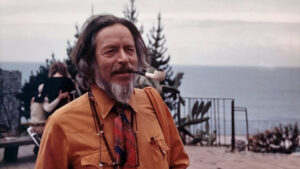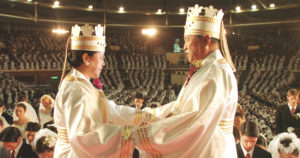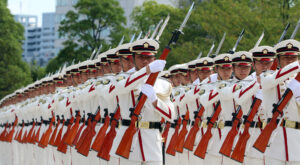When I moved to Japan in the mid-2000s, a friend of mine generously suggested that I was a romantic underachiever doing the equivalent of what thwarted job-seekers in the finance industry referred to as FILTH: Failed In London, Try Hong Kong. Exhibit A, he argued, were the distinctly unbalanced couples to be found walking the streets of Tokyo: geeky young Western men wearing whatever they had woken up in that morning, arm-in-arm with Japanese women who seemed to understand and respect high-end fashion while scorning nature’s hierarchies.
Japanophiles had it tough back then. Tell someone you’re a Francophile, and they’d assume you liked the food, the literature, or had a favourite holiday spot. An Anglophile might stand in cultured awe of Shakespeare, or indulge a misty-eyed reverence for Churchill. By contrast, the “phile” in Japanophile — linked with an assumed attraction to cutesy, submissive femininity within Japanese pop culture — suggested something unhealthy, even unnerving; the need, possibly, to be on a register of some sort.
Since then, however, Western appreciation for Japan has blossomed. Netflix has ramped-up its Japanese offerings, while ever more shelf-space in bookshops and supermarkets is given over to the fantasy worlds of My Hero Academia and One Piece, slightly disappointing sushi, and ingredients marketed with faux-Japanese fonts and logos. This Christmas, white-bearded octogenarian Hayao Miyazaki will gift us his final film on Boxing Day: The Boy and the Heron. It caps a career that has helped to define “Japan” in the West: from ancient, spirit-filled forests to presentations of ordinary urban life in which the transcendent seems always about to break through.
Today, Japan seems more firmly entrenched than ever as a cultural superpower: up there with Italy, France and the United States. And yet something of that old suspicion remains. Express too strong an interest in Japanese culture — and in anime and manga especially — and you risk the accusation of being a “weeb”. The origins of the term lie with the 4chan online imageboard in the early 2000s, where Japan-obsessed white Westerners were derided as “wapanese” — a portmanteau of “wannabe Japanese” or “white Japanese”. Things got heated, and 4chan moderators replaced “wapanese” with the word “weeaboo”, from which “weeb” derives.
Twenty years on, however, there are signs online that the word “weeb” is at last being claimed, with gentle irony, by lovers of Japan across the board. And it’s about time. Extreme anime fans who adopt the clothes and mannerisms of their favourite characters, or give themselves made-up Japanese names, are undoubtedly a bit weird. But high-culture purists can be equally clichéd in their devotion to Japanese art, architecture, martial arts or the good old tea ceremony. And they have more in common with the lowly weebs than they’d care to admit: all are heirs to a history of Western fantasy and longing.
You have to go back nearly 500 years to meet the first weebs. Jesuit missionaries struggled to be taken seriously as bringers of profound metaphysical revelations when Japanese feudal lords saw that they kept livestock in their homes, turned up for meetings in shabby religious attire, lacked various social graces, and rarely seemed to wash. It was under the tutelage of such critics that the Jesuits learned to use chopsticks, take small bites, speak Japanese, appreciate (and indeed perform) the tea ceremony, and dress in a Japanese variant on the traditional Jesuit cassock and cloak.
The Portuguese missionary Luis Fróis was among the greatest of this generation, befriending the legendary warlord Oda Nobunaga and pioneering some of the first cultural comparisons with the West. “In Europe,” he wrote in 1585, “baring even one’s foot before a fire to get warm would be considered strange; in Japan, anyone standing before the fire to get warm unabashedly bares his entire backside…”
In the early 1600s, the Tokugawa shoguns banned all Europeans save the Dutch from trading in Japan in a feat of early-modern border control which Westerners rather conceitedly interpreted as “seclusion” — Japan in fact continued to trade with its nearer neighbours. Being cut off added enormously to the romance of the place, and the first generation to step across a newly reopened Japanese threshold in the 1850s was determined to make the most of it.
Barriers of language and culture enhanced Japan’s exotic appeal. Visiting in the 1870s, the travel writer Isabella Bird commended Japan to her readers as offering “as much novelty perhaps as an excursion to another planet”. The British designer Christopher Dresser was meanwhile perplexed to find the otherwise “genial” and “loving” Japanese indulging the “barbaric cruelty” of slicing a live fish into quivering, edible chunks — a form of cuisine known as ikizukuri. And Irish-Greek writer Lafcadio Hearn, one of the first people to be called a “Japanophile”, described his adopted home of Japan as “a world of lesser and seemingly kindlier beings… the realisation, for imaginations nourished with English folklore, of the old dream of a World of Elves”.
Yet there was a strong sense, too, that the West was polluting Japanese culture. When the British ornithologist and plant collector Collingwood “Cherry” Ingram first visited Japan in the early 1900s, the country appeared Eden-like in its lack of “smoke-begrimed cities” and the cynicism they bred. A few years later, he declared it to be suffering a “violent aesthetic indigestion”, born of taking in too much, too quickly. Plenty of visitors who followed in his footsteps ended up equally disappointed, travelling thousands of miles in search of a pure, pastoral romance long-since lost back home, only to find a far-Eastern Britain under construction.
The desire to catch up with the West, industrially and militarily, seemed to have resulted in purpose crowding out meaning. Children passed through schools having factory or office skills bolted on. Music lessons were motivational: brass bands and singing in unison — the more whimsical Japanese flute and shamisen were deemed shamefully uncivilised. Clocks were everywhere. The Emperor’s personal tutor spoke for a great many Japanese conservatives when he worried about adopting too much from “foreign civilisations [whose] only values are fact-gathering and technique”.
Indeed, Westerners whose love of Japan was premised on its vaunted depth and purity were not short of allies among the Japanese. They included Okakura Kakuzō, author — in English, for such was his target audience — of The Ideals of the East (1903). He claimed that modern Japan was uniquely placed to steward the “Asiatic soul” and replenish its desiccated Western counterpart. Similar ideas were put forward by Japanese advocates of Zen, and Buddhism more broadly. Some even went on lecture tours of America and Europe, marrying critiques of modern Western life with classes on how to meditate.
This sort of thing annoyed some Japanese commentators. While they were pleased to see their country garnering respect abroad, they worried that a reputation for kindliness and passivity risked holding it back. The Indian poet and friend of Okakura, Rabindranath Tagore, visited Japan on a speaking tour during the First World War and lauded a “culture that enjoins man to look for his true wealth and power in his inner soul”. One Japanese critic in the audience pointed out that Japan had lately done rather well out of wealth of the economic sort, and power of the kind that went “bang” — just ask the Russians, defeated by Japan’s modern armed forces in 1905. Another dismissed Tagore’s message as “the song of a ruined country”.
On that same tour, Tagore warned his hosts about succumbing to the temptations of European-style nationalism. Heading down that very path in the mid-20th century, Japan suddenly found itself short on Western admirers. When eventually they returned, it was for much the same reasons: Japan as a place of stillness, spaciousness and quiet. Dignified longing was offered up in the films of Yasujiro Ōzu (Tokyo Story, 1953) and the novels of Yasunari Kawabata, Japan’s first Nobel Prize laureate for literature. And Japanese cultural diplomacy steered artfully clear of the country’s recent history, leaning heavily instead on peaceful, timeless art-forms: ikebana (flower-arranging), the tea ceremony, calligraphy, sushi.
Japan’s radical art of the Sixties and Seventies — from painting to performance — struggled to find a mass audience in the West, perhaps because it was too familiar in its forms and political concerns. Instead, manga and anime became the first elements of non-traditional Japanese culture to travel westward, pioneered by artists who had lived through the war or its immediate aftermath, who sought to show Japanese children just how compromised and corrupt the adult world could be. Osamu Tezuka (“godfather of manga”) was part of that group, as were Hayao Miyazaki and Yanase Takashi — the latter not well-known in the West, but adored in Japan for his children’s superhero Anpanman. Japan’s centuries-old tradition of visual satire and storytelling — myths, ghosts, jokey takes on everyday life (one of Japan’s oldest surviving cartoons depicts a fart battle) — was reworked to create fantastical characters and worlds, in which childlike innocence was shown capable of winning out over darker forces.
Japan’s political leaders slowly cottoned on to the potential of enhancing Japan’s reputation abroad while providing a counterbalance to American cultural imports. Talk emerged in the early 2000s of “cool Japan”, and politicians began taking awkward photos alongside anime characters like Doraemon. Western critics pointed out the disparity between the fun, vibrant and ultra-modern on-screen fare and Japan’s creaky political situation, under which the economy sputtered and women struggled to be taken seriously in the workforce. Was there not something a little wrong, they wondered, with filling the pockets of Japanese culture industries whose job seemed to be to supply just enough comfort and creativity to keep moral or political despair at bay?
A defence of weebery may be exactly what we need, as it looks like it will be a major ally of Britain for years to come. At its best, anime shows us how people in different parts of Japanese society imagine and understand themselves. Cultural diplomacy may even be easing Japan’s relationships with its East Asian neighbours, balancing out the strong anti-Japanese sentiment in education systems and political discourse. It is perfectly possible to love My Neighbour Totoro and hold unforgiving views of Japanese colonialism and war-making in the 20th century. But surveys suggest that Japanese pop culture, combined with tourism, is encouraging young Chinese and Koreans to think about Japan primarily in terms of quality entertainment (more relatable than American fare, given shared cultural roots), tasty food, politeness, convenience and good shopping. Far more Chinese can name a Japanese pop-culture classic than the other way around. If dishing out Belt and Road money turns out to be a flop, China’s leaders may find themselves desperate for the Chinese equivalent of a weeb debate.
Ralph Waldo Emerson once warned, with Western fans of Indian culture in mind, that “every man has a fairy-land just beyond the compass of his horizon”. But to wonder whether life might be better elsewhere is surely to wonder whether life could be better, full-stop. Whatever your views on weebery, that is surely the sort of wondering with which we ought never to lose touch.
Disclaimer
Some of the posts we share are controversial and we do not necessarily agree with them in the whole extend. Sometimes we agree with the content or part of it but we do not agree with the narration or language. Nevertheless we find them somehow interesting, valuable and/or informative or we share them, because we strongly believe in freedom of speech, free press and journalism. We strongly encourage you to have a critical approach to all the content, do your own research and analysis to build your own opinion.
We would be glad to have your feedback.
Source: UnHerd Read the original article here: https://unherd.com/






